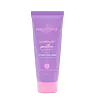What's inside
What's inside
 Key Ingredients
Key Ingredients

 Benefits
Benefits

 Concerns
Concerns

 Ingredients Side-by-side
Ingredients Side-by-side

Aloe Barbadensis Leaf Juice
Skin ConditioningCocamidopropyl Betaine
CleansingDecyl Glucoside
CleansingDisodium Cocoyl Glutamate
CleansingButylene Glycol
HumectantSalicylic Acid
MaskingAcrylates/C10-30 Alkyl Acrylate Crosspolymer
Emulsion StabilisingCentella Asiatica Extract
CleansingCamellia Sinensis Leaf Extract
AntimicrobialMelaleuca Alternifolia Leaf Oil
AntioxidantZinc PCA
HumectantLactobacillus/Pear Juice Ferment Filtrate
Skin ConditioningPhellodendron Amurense Bark Extract
Skin ConditioningSalix Alba Bark Extract
AstringentRehmannia Chinensis Root Extract
Skin ConditioningMelia Azadirachta Leaf Extract
Skin ConditioningScutellaria Baicalensis Root Extract
AstringentHouttuynia Cordata Extract
Skin ConditioningGlycine Soja Seed Extract
Skin ConditioningMentha Piperita Oil
MaskingSodium Hydroxide
BufferingPEG-40 Hydrogenated Castor Oil
EmulsifyingCamphor
MaskingBenzophenone-4
UV AbsorberPanthenol
Skin ConditioningXanthan Gum
EmulsifyingDisodium EDTA
Benzyl Alcohol
PerfumingEthylhexylglycerin
Skin ConditioningTocopherol
AntioxidantCI 19140
Cosmetic ColorantCI 42090
Cosmetic ColorantAloe Barbadensis Leaf Juice, Cocamidopropyl Betaine, Decyl Glucoside, Disodium Cocoyl Glutamate, Butylene Glycol, Salicylic Acid, Acrylates/C10-30 Alkyl Acrylate Crosspolymer, Centella Asiatica Extract, Camellia Sinensis Leaf Extract, Melaleuca Alternifolia Leaf Oil, Zinc PCA, Lactobacillus/Pear Juice Ferment Filtrate, Phellodendron Amurense Bark Extract, Salix Alba Bark Extract, Rehmannia Chinensis Root Extract, Melia Azadirachta Leaf Extract, Scutellaria Baicalensis Root Extract, Houttuynia Cordata Extract, Glycine Soja Seed Extract, Mentha Piperita Oil, Sodium Hydroxide, PEG-40 Hydrogenated Castor Oil, Camphor, Benzophenone-4, Panthenol, Xanthan Gum, Disodium EDTA, Benzyl Alcohol, Ethylhexylglycerin, Tocopherol, CI 19140, CI 42090
Water
Skin ConditioningSodium Lauroyl Sarcosinate
CleansingAcrylates Copolymer
Disodium Cocoamphodiacetate
CleansingGlycerin
HumectantCocamidopropyl Betaine
CleansingSodium PCA
HumectantBetaine
HumectantSodium Hydroxide
BufferingBenzophenone-4
UV AbsorberSodium Benzoate
MaskingPotassium Sorbate
PreservativePanthenol
Skin ConditioningDioscorea Villosa Root Extract
Skin ConditioningNiacinamide
SmoothingGlyceryl Glucoside
HumectantDisodium EDTA
Sodium Ascorbyl Phosphate
AntioxidantMenthol
MaskingAlpha-Arbutin
AntioxidantHyaluronic Acid
HumectantCI 60730
Cosmetic ColorantParfum
MaskingWater, Sodium Lauroyl Sarcosinate, Acrylates Copolymer, Disodium Cocoamphodiacetate, Glycerin, Cocamidopropyl Betaine, Sodium PCA, Betaine, Sodium Hydroxide, Benzophenone-4, Sodium Benzoate, Potassium Sorbate, Panthenol, Dioscorea Villosa Root Extract, Niacinamide, Glyceryl Glucoside, Disodium EDTA, Sodium Ascorbyl Phosphate, Menthol, Alpha-Arbutin, Hyaluronic Acid, CI 60730, Parfum
Ingredients Explained
These ingredients are found in both products.
Ingredients higher up in an ingredient list are typically present in a larger amount.
Benzophenone-4 is a water-soluble chemical sunscreen.
It protects in the UV-B range, but is considered a secondary UV absorber. This means that it needs to be paired with other sunscreen ingredients to provide effective protection.
Typically, it's used in cosmetic products to protect them from deterioration caused by UV rays. This is why you'll find it in a lot of products that aren't sunscreens.
Learn more about Benzophenone-4Cocamidopropyl Betaine is a fatty acid created by mixing similar compounds in coconut oil and dimethylaminopropylamine, a compound with two amino groups.
This ingredient is a surfactant and cleanser. It helps gather the dirt, pollutants, and other impurities in your skin to be washed away. It also helps thicken a product and make the texture more creamy.
Being created from coconut oil means Cocamidopropyl Betaine is hydrating for the skin.
While Cocamidopropyl Betaine was believed to be an allergen, a study from 2012 disproved this. It found two compounds in unpure Cocamidopropyl Betaine to be the irritants: aminoamide and 3-dimethylaminopropylamine. High-grade and pure Cocamidopropyl Betaine did not induce allergic reactions during this study.
Learn more about Cocamidopropyl BetaineDisodium EDTA plays a role in making products more stable by aiding other preservatives.
It is a chelating agent, meaning it neutralizes metal ions that may be found in a product.
Disodium EDTA is a salt of edetic acid and is found to be safe in cosmetic ingredients.
Learn more about Disodium EDTAPanthenol is a common ingredient that helps hydrate and soothe the skin. It is found naturally in our skin and hair.
There are two forms of panthenol: D and L.
D-panthenol is also known as dexpanthenol. Most cosmetics use dexpanthenol or a mixture of D and L-panthenol.
Panthenol is famous due to its ability to go deeper into the skin's layers. Using this ingredient has numerous pros (and no cons):
Like hyaluronic acid, panthenol is a humectant. Humectants are able to bind and hold large amounts of water to keep skin hydrated.
This ingredient works well for wound healing. It works by increasing tissue in the wound and helps close open wounds.
Once oxidized, panthenol converts to pantothenic acid. Panthothenic acid is found in all living cells.
This ingredient is also referred to as pro-vitamin B5.
Learn more about PanthenolSodium Hydroxide is also known as lye or caustic soda. It is used to adjust the pH of products; many ingredients require a specific pH to be effective.
In small amounts, sodium hydroxide is considered safe to use. However, large amounts may cause chemical burns due to its high alkaline.
Your skin has a natural pH and acid mantle. This acid mantle helps prevent harmful bacteria from breaking through. The acid mantle also helps keep your skin hydrated.
"Alkaline" refers to a high pH level. A low pH level would be considered acidic.
Learn more about Sodium Hydroxide